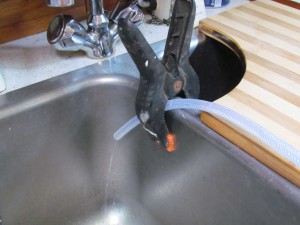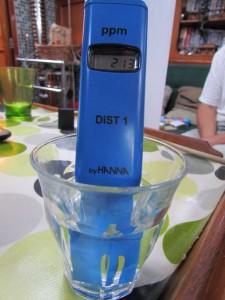and we can now make some to drink!
When we bought Emerald in America back in 2004, we got a bit over excited in the chandleries there as at the time the dollar to £ was almost 2 to 1. We ended up cramming Emerald with lots of goodies including solar panels and a watermaker. Back in the UK they were stored in the garage of our house ready for the day we sailed away – at that point we had a 5 year plan.

Access hole for the watermaker and to let out heat. Also handy for storing the pickling and cleaning chemicals
The plan got delayed a couple of years and eventually the watermaker was mounted on the wall of the engine room but wasn’t plumbed in. There it stayed as we sailed Denmark, Sweden and Norway and almost twice around the UK. Finally in our 18 month layover in Essex came the chance to plumb it in. It was moved out of the engine room as we read the heat the engine generates could damage the membrane. Instead it went under our long saloon seat, which we had to widen to fit it in, but we wanted to make it wider anyway to make it a more comfortable sea berth. We were able to use an unused seacock (we never knew what it was originally used for) under the galley floor for water in and the waste product was directed to the same seacock that our cockpit drains connect to. We added an extra prefilter to that recommended in the installation instructions. The ‘clean water’ could be directed to either our 60l tank under the galley floor or to a standalone water can.
So, all plumbed in and ready to go as we headed off south in 2013. But we never felt the need to start using it as there was always plentiful water available wherever we went. Once we started using it we would need to use it regularly or pickle it, so we just never started using it.
At some point we contacted Katadyn who make our PowerSurvivor 80 unit to ask them if they thought the membrane would be OK having been stored for so long. They thought it probably would but nobody had ever been in that situation before. We decided 2015 must be the year to try it out – we could then get a new membrane over the following winter if needs be. There is fresh water available in Greece from marinas and town quays but we’re not keen on Med mooring and want to remove any reasons to have to do it. Plus the water in most of the bays here is very clean so we would be able to make water in most places.
So here we are in Bungalow Bay, the water here is much cleaner than in Vlicho and we want to give the watermaker all the help we can. A quick review of the instructions and then a check of all the pipe and valve fittings to make sure nothing had worked loose. All good.
With the unit set to prime/clean we switched it on. We watched the water get sucked up into the seacock pipe and into the filter (we used clear pipes). Then excitement as it reached the watermaker. Then unsure why it wasn’t coming out of the outlet pipe at the other side of the watermaker. Where was it going? Dur, of course it was being directed out of the waste water pipe!
We left it running on clean for half an hour. Then the big moment as it was switched to run. We watched the water flow in fits and starts along the outlet pipe before spurting into the sink. We let it run for a few minutes before testing a glassful for purity: 301ppm. We’d sampled a cup of tap water beforehand and got 222ppm. The ppm is an indication of the cleanliness of the water; according to the internet saltwater is about 35000 ppm so the unit was doing a very good job. I had a taste – it was good; no salt, no chemical aftertaste, just pure, clean water. Time to direct into our can.
We decided not to fill directly into our tanks this first time in case something went wrong and we contaminated our tank supply. We have a 30l can which we could fill instead and pour into the tanks. So now after nearly 2 and a half hours we have made a can full, final ppm being 139.
One of the reasons we chose this unit was for its low power consumption. We didn’t want to have to run the engine or petrol generator to power it, there’s enough heat in the boat without adding several hours of engine heat to it (it’s currently 33C in the saloon) and IGOR the generator is very noisy. The PowerSurvivor is speced to run off 12v and use only 8amps, our solar panels and wind generator have kept up with power usage for the 3 hours we’ve ran it for today. Slow but steady!
It’s quiet too, just a low level wiggly-woo whir (Colin’s description) from the pump and a gentle burbling as the waste product gets directed down our cockpit drains.
Now we can let Katadyn know of our success and maybe they’ll send us a nice present for being guinea pigs for long term storage of their watermakers 😉



